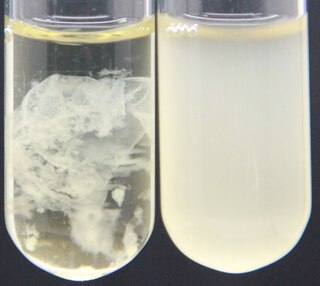Related Research Articles

Pseudomonadota is a major phylum of Gram-negative bacteria. The renaming of several prokaryote phyla in 2021, including Pseudomonadota, remains controversial among microbiologists, many of whom continue to use the earlier name Proteobacteria, of long standing in the literature. The phylum Proteobacteria includes a wide variety of pathogenic genera, such as Escherichia, Salmonella, Vibrio, Yersinia, Legionella, and many others. Others are free-living (non-parasitic) and include many of the bacteria responsible for nitrogen fixation.

The Rhodospirillales are an order of Pseudomonadota.

Thermus is a genus of thermophilic bacteria. It is one of several bacteria belonging to the Deinococcota phylum. Thermus species can be distinguished from other genera in the family Thermaceae as well as all other bacteria by the presence of eight conserved signature indels (CSIs) found in proteins such as adenylate kinase and replicative DNA helicase as well as 14 conserved signature proteins (CSPs) that are exclusively shared by members of this genus.

The Hyphomicrobiales are an order of Gram-negative Alphaproteobacteria.

The Rhodocyclales are an order of the class Betaproteobacteria in the phylum "Pseudomonadota". Following a major reclassification of the class in 2017, the previously monofamilial order was split into three families:

Sphingomonadaceae are a gram-negative bacterial family of the Alphaproteobacteria. An important feature is the presence of sphingolipids in the outer membrane of the cell wall. The cells are ovoid or rod-shaped. Others are also pleomorphic, i.e. the cells change the shape over time. Some species from Sphingomonadaceae family are dominant components of biofilms.

The Brucellaceae are a family of the Gram-negative Hyphomicrobiales. They are named after Sir David Bruce, a Scottish microbiologist. They are aerobic chemoorganotrophes. The family comprises pathogen and soil bacteria
In taxonomy, Ruegeria is a genus of the Rhodobacteraceae. This genus was formerly known as the marine Agrobacterium before they were reclassified in 1998. It bears in fact the name of Hans-Jürgen Rüger, a German microbiologist, for his contribution to the taxonomy of marine species of Agrobacterium.

Alphaproteobacteria is a class of bacteria in the phylum Pseudomonadota. The Magnetococcales and Mariprofundales are considered basal or sister to the Alphaproteobacteria. The Alphaproteobacteria are highly diverse and possess few commonalities, but nevertheless share a common ancestor. Like all Proteobacteria, its members are gram-negative and some of its intracellular parasitic members lack peptidoglycan and are consequently gram variable.
The Chloroflexota are a phylum of bacteria containing isolates with a diversity of phenotypes, including members that are aerobic thermophiles, which use oxygen and grow well in high temperatures; anoxygenic phototrophs, which use light for photosynthesis ; and anaerobic halorespirers, which uses halogenated organics as electron acceptors.
The Sphingomonadales are an order of the Alphaproteobacteria.
Rhodopila globiformis is a species of bacteria, formerly known as Rhodopseudomonas globiformis. It is a motile, spherical organism. Cells can grow between 1.6 and 1.8 μm in diameter. The photopigments consist of bacteriochlorophyll aP and aliphatic methoxylated ketocarotenoids. The organism grows under anaerobic conditions in the light or under microaerophilic conditions in the dark. Biotin, p-aminobenzoic acid and a source of reduced sulfur are required as growth factors in order to cultivate this bacteria. This bacteria possesses a high potential cytochrome c2.
Rhodocyclus purpureus is a species of bacteria. Its cells are half-ring-shaped and ring-shaped before cell division; the half-rings being 0.6 to 0.7 μm wide and 2.5 to 3.0 μm long. Open or compact coils of variable length are also formed. It is facultatively aerobic and its type strain is “Ames” 6770.
Psychrobacter is a genus of Gram-negative, osmotolerant, oxidase-positive, psychrophilic or psychrotolerant, aerobic bacteria which belong to the family Moraxellaceae and the class Gammaproteobacteria. The shape is typically cocci or coccobacilli. Some of those bacteria were isolated from humans and can cause humans infections such as endocarditis and peritonitis. This genus of bacteria is able to grow at temperatures between −10 and 42 °C. Rudi Rossau found through DNA-rRNA hybridization analysis that Psychrobacter belongs to the Moraxellaceae. The first species was described by Juni and Heym. Psychrobacter occur in wide range of moist, cold saline habitats, but they also occur in warm and slightly saline habitats.
Enhydrobacter aerosaccus is a gram negative, catalase- and oxidase-positive, non motile bacterium which contains gas vacuoles from the genus of Enhydrobacter which was isolated from the Wintergreen Lake in Michigan.
Methylorubrum rhodesianum is a species of alphaproteobacteria. It has been found on the International Space Station (ISS) amongst others.
Roseivivax halodurans is a species of bacteria, the type species of its genus. It is aerobic and bacteriochlorophyll-containing, first isolated from the charophytes on the stromatolites of a saline lake located on the west coast of Australia. It is chemoheterotrophic, Gram-negative, motile, rod-shaped and with subpolar flagella. Its type strain is OCh 239T.
Rhodoplanes is a phototrophic genus of bacteria. Rhodoplanes produces hopanoids like diplopterol, tetrahymanol, 2-methyldiplopterol, 2-methyltetrahymanol, bacteriohopanetetrol, bacteriohopaneaminotriol and carotenoids like spirilloxanthin, rhodopin, anhydrorhodovibrin, 1,1′-dihydroxylycopene and 3,4,3′,4′-tetrahydrospirilloxanthin
Terasakiella is a genus of bacteria from the order Rhodospirillales.
Tistrella is a bacterial genus from the family of Rhodospirillaceae. Tistrella produces didemnins.
References
- 1 2 LPSN bacterionet
- ↑ Taxonomy Browser
- ↑ John G Holt (1 October 1993). Bergey's Manual of Determinative Bacteriology (9 ed.). Lippincott Williams & Wilkins. ISBN 0683006037.
- ↑ Kawamura, Y.; Fujiwara, N.; Naka, T.; Mitani, A.; Kubota, H.; Tomida, J.; Morita, Y.; Hitomi, J. (2012). "Genus Enhydrobacter Staley et al. 1987 should be recognized as a member of the family Rhodospirillaceae within the class Alphaproteobacteria". Microbiology and Immunology. 56 (1): 21–26. doi: 10.1111/j.1348-0421.2011.00401.x . PMID 22145860. S2CID 26738769.
- ↑ Staley, James (July 1987). "Enhydrobacter aerasaccus gen. nov. , sp. nov. a Gas-Vacuolated, Facultatively Anaerobic, Heterotrophic Rod" (PDF). International Journal of Systematic Bacteriology. 37 (3): 289–291. doi:10.1099/00207713-37-3-289 . Retrieved 8 November 2018.